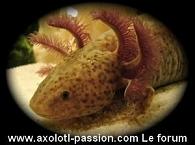Hi every one,
In Europe we have the colour named "copper" or "cake". Thise colour is very rare and we don't know the genetic.
I would like to know if these axolotls also are in other countries, and what you know about these axolotls.
We know that : This color is composed of shades of brown with dark brown spots, yellow and shiny copper, but no black. The axolotl is not very dark. It is not melanoid, or albino, nor Axanthic.
My hypothesis is that it is hypomelanism (h) and therefore the individual is homozygous for hypomelanic h (h / h). In all cases the experience of farmers show that copper is a recessive color.
In Germany some people think that the copper is more sensitive (mycosis, and healthproblem) but others don't. My two are in really good health. I think maybe some people did too much consanguinity. I want to undo that with my to healthy coppers (whose parents and greatparents are in good healthy too).
I have 2 of these "copper" axolotls and i can show you more pictures if you need


In Europe we have the colour named "copper" or "cake". Thise colour is very rare and we don't know the genetic.
I would like to know if these axolotls also are in other countries, and what you know about these axolotls.
We know that : This color is composed of shades of brown with dark brown spots, yellow and shiny copper, but no black. The axolotl is not very dark. It is not melanoid, or albino, nor Axanthic.
My hypothesis is that it is hypomelanism (h) and therefore the individual is homozygous for hypomelanic h (h / h). In all cases the experience of farmers show that copper is a recessive color.
In Germany some people think that the copper is more sensitive (mycosis, and healthproblem) but others don't. My two are in really good health. I think maybe some people did too much consanguinity. I want to undo that with my to healthy coppers (whose parents and greatparents are in good healthy too).
I have 2 of these "copper" axolotls and i can show you more pictures if you need


Last edited:




